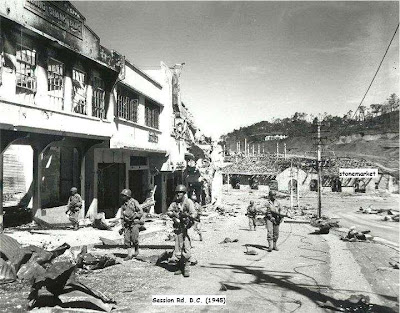Maru Bagac Foundation Farm Slideshow: Benedict’s trip from Luzon, Philippines to Angeles City (near Angeles) was created by TripAdvisor. See another Angeles slideshow. Take your travel photos and make a slideshow for free.
The Intertech logo is a representation of people, their development, our concern for the environment.
Nickel-Laden road beds

A cooperative mining project - in a reality of people, their struggles and their loves . .
Tuesday, March 27, 2012
Sapang Bato Farms
Mga etiketa:
food valley,
foundation. agri zone
Monday, March 19, 2012
Maru Bagac + Intertech
March 18, 2012, FloridaBlanca, Pampanga, Philippines:
The MARU BAGAC MULTI SECTORAL FOUNDATION has opened up a huge project development program for its property at Floridablanca Pampanga, Philippines. The investment plans consisted of a Foreign-funded bio-ethanol production facility to be established independently by Foreign Investors, and more importantly the establishment of a modern trauma-medical Tourism Hospital worth PHP1.0 billion; a mixed-used housing and wellness community for PHP500.0 Million; an agri-agro economic zone to be named the Maru Bagac Food Valley worth PHP2.0 billion; An Integrated Paper processing facility and kenaf production project worth PHP400 million; and an Integrated Coffee production and processing facility worth PHP200 million; and a proposed Bank development subsidiary to be named Goodshepherd Bank;
Several Corporate sponsors, Partners and Affiliates have been tapped to implement these projects among which are Intertech and Ballbros Corp., among others.
 |
| Maru Bagac Foundation - Logo |
Several Corporate sponsors, Partners and Affiliates have been tapped to implement these projects among which are Intertech and Ballbros Corp., among others.
Tuesday, March 13, 2012
Mga etiketa:
foundation,
maru bagac,
proejcts
Tuesday, March 6, 2012
Be Simply Human
 |
| walang alam - huggable naman!! |
There was a time that i beckon to ignorance - coz it makes
us all teachable - and so that makes us adorable . . and
when we became learned - we spank ourselves with titles
of honor that never valued us back - then to our vanity,
we added a cauldron of seeming intelligence over our heads
that we thought we have gained in fact - but somehow
loosened our true self worth which is the real US - the
person within . . and i just wonder at all the levity we
exercised upon others to show how much different we
are - gravitating to a human "black hole" of knowledge
that might be our own making . . . from which direction
we may all end up in a simple vapor of ignominy . . .
so i dare say this to all who listen -
BE SIMPLY HUMAN!! . . .
Sunday, March 4, 2012
The solution to Mining is "small-scale mining" approach
Solution is to control
“The solution is not to ban mining but to control it,” he said.
“We must have mining. It’s just impossible to live without mines
and you can’t say do it somewhere else. It’s un-Christian,”
Wallace said.
Wallace, an Australian expatriate and longtime Philippine
resident, said that if the Philippines were to harness
mining, it would create hundreds of thousands more
jobs, build more roads and bring basic utilities like
But if the government were to ban mining,
illegal mining would still exist, he said.
Brimo said mining, tourism and agriculture were not
mutually exclusive and these industries could
co-exist with each other.
Brimo also shrugged off concerns on the
environmental footprint of mining, noting that
it’s very difficult to find viable mining sites
anywhere in the world. He noted that only 62,000
hectares, or 0.2 percent of the land mass in the country
was covered by mining claims.
Out of every 25,000 mining prospects in the world, only
500 will be seriously explored and only one will become
a live mining project, he said.
Very strict parameters
Lawyer Christian Monsod, a consultant for the Manila
Electric Co., said he was in favor of mining
but under very strict parameters.
He said mining could benefit the country
if four conditions are met: that environmental
and social costs are accounted for; that the
country gets full share of value of extracted
minerals; the institutional capacity of
government must be put in place; and money
for mining must be used to create new capital,
including human capital and boost infrastructure
in the countryside.
At a press briefing after the forum, Chamber of
Mines president Philip Romualdez said
small-scale mining must be subjected to the
same regulatory net as large-scale miners and
it would take political will to do so.
Although tourism is another potential growth
driver for the Philippines as cited by
environmentalists, Pangilinan said most mining sites
were not ideal for tourism.
“Our mines in Padcal and Surigao are hardly suitable
for tourism, simply because they don’t have the features
of an attractive tourist site. And even if tourism were
possible, we must ask: Are the expected returns from
tourism comparable to the benefits which mining can
provide?” Pangilinan said.
“Mining is not the enemy, poverty is,” he said.
Pangilinan also said a government plan to introduce
the concept of “total economic value,” or TEV,
in assessing mining opportunities was “intangible,
elusive and extremely subjective.”
“How does one quantify and test the value
attached to the beauty of a sunset, the feel of
early morning mist or the music of water rippling
through a stream?” he said.
Industry not perfect
In his presentation, Pangilinan admitted that the
mining industry was not perfect, which sometimes
leads to perception that mining is dangerous and
destructive. He suggested the following:
That national and local policies on mining need to
be harmonized and the cooperation of local government
units must be procured in order to subject small-scale
miners to the same regulation as large-scale miners;
That the capacity and competence of state regulators
be improved, particularly in regard to equipment and
quantity and quality of regulatory staff;
That there must be an independent environmental
commission responsible for supervising and enforcing
environmental concerns;
That the private sector be open to a profit-sharing
scheme which will assure the government of a more
appropriate share in the benefits derived from resources; and
That mining benefits between host local government
units and the national government be shared more equitably.
It was during his discussion of the Padcal mine in
Benguet that Pangilinan inadvertently brought the
face-off to a climax when he figured in a heated
exchange with environmentalist Regina Lopez,
managing director of the ABS-CBN Foundation.
Government for mining
Government representatives at the forum indicated
that government was not against mining but that
the industry should be made to cough up more
money, mainly because of its bad track record in the
Philippines and the country’s need for more revenues.
In a speech at the conference, Jasareno said the
extractive industry should not run away from its
responsibility to the environment and the people.
Environment Secretary Ramon Paje said the provision
imposing a 5 percent royalty fee on top of the 2
percent excise tax that mining companies are already
paying would not be changed in the executive order on
the new mining policy that is being drafted by Malacañang.
Those who want to amend this should bring their case
to the President, said Paje as he stressed that the mining
industry is getting finite resources from the Philippines.
According to Jasareno, the government recognizes the
value of the country’s abundant mineral resources like
gold, copper, iron and nickel, and the need to work
with the mining industry.
“The government is aware that left on the ground,
these minerals cannot generate wealth for the Filipino
people. And the country needs wealth,” he said.
300K small-scale mines
Jasareno said there are 31 mining companies operating
in the Philippines. Small-scale miners number between
200,000 and 300,000. Permits and mining claims cover
1.14 million hectares, or 3.8 percent, of the country’s total land area.
He said there are eight projects in the pipeline that
will significantly contribute to the country’s mineral
output in the next two to three years.
The country’s mining sector has been experiencing
a boom in the past year owing to the high prices
of precious metals, particularly gold.
In 2011, the metallic mining sector posted a
gross production value of P122 billion, a
9-percent increase from the P112 billion posted in 2010.
GDP contribution
Despite the mining industry’s improved earnings
over the years, however, its contribution to the
gross domestic product has not increased.
According to Jasareno, the contribution of
mining to GDP “has not been able to breach
the 1.5-percent barrier for a long time now.”
“Mining’s contribution to total exports is also
similarly situated,” he said.
Paje said the government loses P5 billion every
year from not collecting royalty fees from mining companies.
Jasareno said the mining industry’s presence
in the Philippines over the years has left communities
with a “nightmare” in their backyard, giving the entire
industry the bad image of a despoiler of the environment.
“Mining operations in the past have left behind legacy
mines, or mines that were simply abandoned by the
mining operators without doing rehabilitation work.
They are not just gaping holes, but also sources or
causes of acid mine drainage, siltation, ghost towns
and other nightmares to the host communities,” he said.
“They have become the rallying point of people who oppose
new mining projects on the simple understanding that such
new mining projects will end up as new legacy mines,”
Jasareno said.
Subscribe to:
Posts (Atom)






.jpg)
.jpg)
.jpg)
.jpg)
.jpg)
.jpg)
.jpg)
.jpg)


